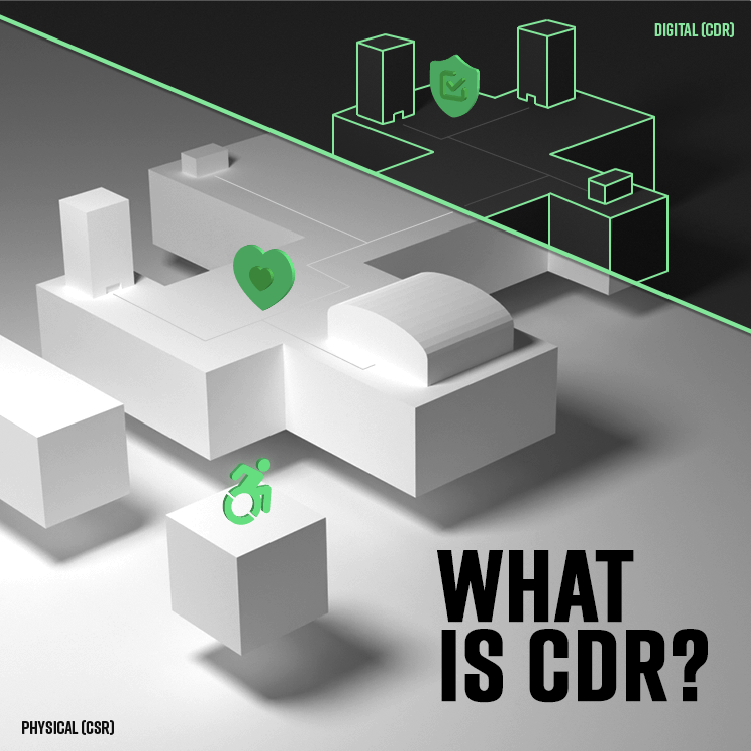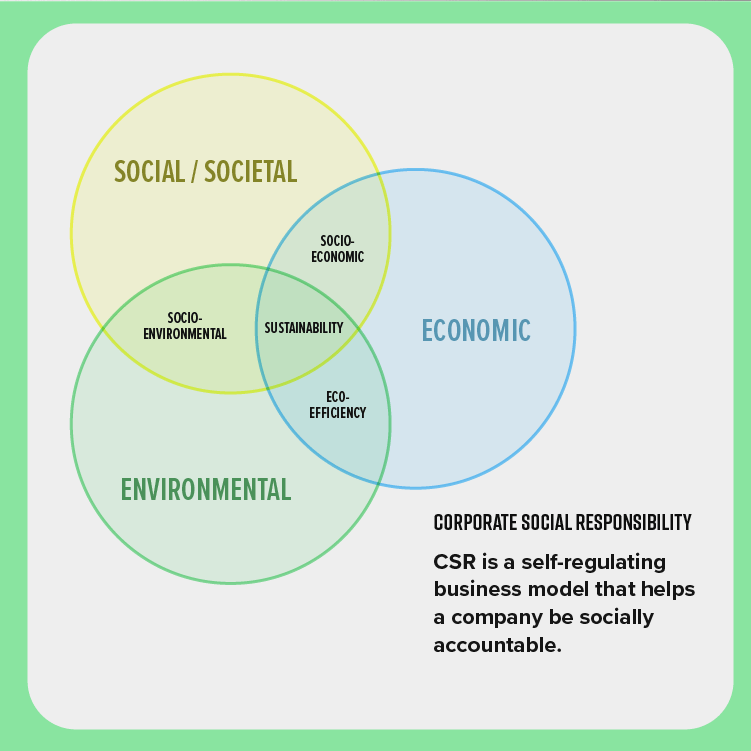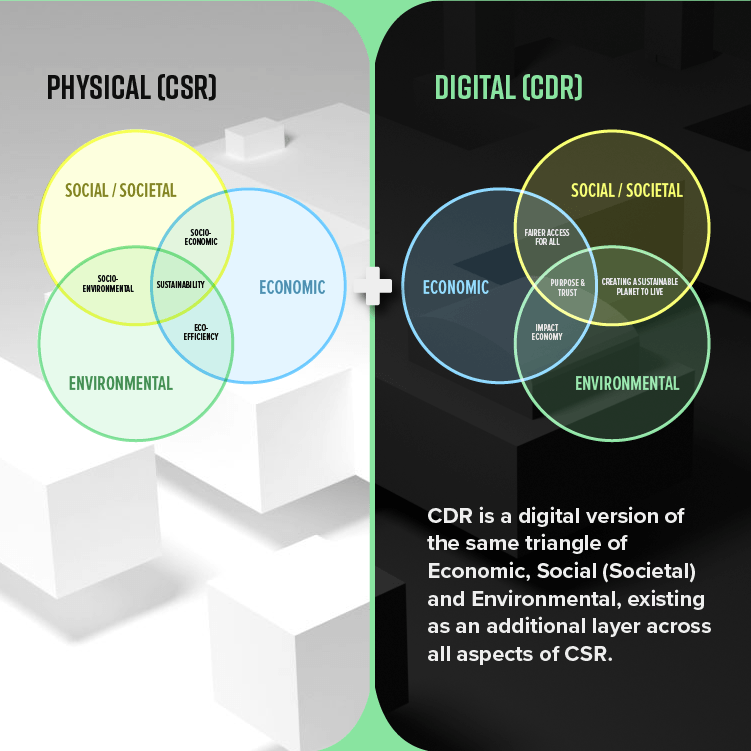What is Corporate Digital Responsibility?

Rigged elections, e-waste, racist algorithms, increasing income inequality…what is the dark side of digital transformation? In this guide, we share a framework for integrating corporate digital responsibility (CDR) practices across your organization.
The Consequences of Ubiquitous Technology
Imagine the damage that could be caused by a weapon controlled by malevolent AI, the impact of a total loss of personal privacy, or the social and economic costs of unregulated gig-economy jobs with few or no social protections. The potential outcomes of these and other scenarios are starting to be openly discussed within governments and civil society. Now corporate entities need to join the debate.
— Michael Wade, MIT Sloan Management Review
Digital products and services impact everything we do. However, consequences (unintended or otherwise) occur when digital practices aren’t carefully tested, implemented, or managed over time. For example:
- Tech media publications increasingly feature stories about racist AI algorithms and autonomous vehicle deaths. Did the people who designed these products intend for them to be biased or murder machines? Probably not. However, these problems unfolded nonetheless.
- Most digital products—including, perhaps, your own website—don’t provide equitable access to content for people with disabilities, those in low-bandwidth areas, or people using older devices. Depending on the information needed, this could be potentially life-threatening.
- Misinformation and conspiracy theories are running rampant across social media platforms, undermining the very fabric of our society. Look no further than the U.S. Capitol siege on January 6, 2021, which was fueled by misinformation, for evidence of how dangerous this can be.
Concerns about these issues are growing. Environmental, social, and economic issues related to digital technologies are piling up. The points listed above just scratch the surface of how improperly managed digital products and services can have terrible consequences.
Fostering Responsible Digital Transformation
Conversely, existing and emerging technologies also show great promise in addressing some of our world’s biggest challenges. They should be embraced and explored by all organizations. However, organizations won’t be successful long-term without strong governance policies and practices in place—in other words, digital transformation, to borrow an overused and often misunderstood term.
Currently, that’s not happening within many organizations. As these stories of tech products gone sideways become more common, we must fundamentally shift how organizations implement responsible digital practices.
Mightybytes is and always has been a digital-native company. We are deeply committed to using digital products, services, and practices responsibly. As a Certified B Corp, we also work to build a more inclusive and regenerative economy, for which digital plays a key role. That’s why we’re embracing a new set of standards for corporate digital responsibility.
Let’s dig a little deeper into what this actually means.

The Next Evolution of Corporate Social Responsibility (CSR)
The ethical design and uses of digital technologies and related data is not solely a technological challenge (e.g., developing algorithms for ethical reasoning). Rather, it requires organizations to develop a comprehensive, coherent set of norms, embedded in their organizational culture, to govern the development and deployment of digital technology and data.
— Corporate Digital Responsibility, Journal of Business Research, Elsevier
When Corporate Social Responsibility (CSR) was first introduced by economist Howard Bowen back in 1953, digital was still, to most people, the stuff of science fiction. After all, at the time a single computer filled an entire room. Consequently, an antiquated definition of responsible corporate practices, while still useful, falls woefully short in light of how most digitally-enabled business is conducted.
To clarify, this isn’t to say that CDR should replace CSR. Rather, the two should complement and support one another. Also, Corporate Digital Responsibility isn’t just CSR with the word ‘digital’ slapped into it. Though they share the same overarching structure, CDR combines ethical digital transformation principles with responsible and more sustainable business practices. The result is an organizational framework for the 21st century.
Most importantly, with existential problems like the climate crisis looming, the sooner we can implement this framework into as many organizations as possible, the better.
Digital Responsibility is for All Organizations
Also, while the business sector is CDR’s primary target—the word corporate is right in the name, after all—these principles apply to any organization. Nonprofits and civic agencies would do well to align their policies and procedures with corporate digital responsibility principles.

The Changing Face of Corporate Responsibility
In my original research for this post, conducted mid-2020, one academic paper noted that only eight leading journals have published about 50 papers on this and related topics since 1986. Also, those academic papers didn’t often dole out concrete advice but rather explored the CDR landscape—or the potential for one.
Moreover, many businesses might already have policies or guidelines in place around practices like social media use, privacy, cybersecurity, accessibility, and so on. Also, depending on an organization’s priorities, sometimes this work lives under the guise of other names:
- Digital Ethics
- Green Computing
- Digital Sustainability
- Ethical Marketing
- Sustainable Design
- Circular Design
- And yes, of course, Corporate Social Responsibility
To clarify, each of these unique disciplines overlaps in some way with CDR. Similarly, each is also often the purview of an individual department or business unit within an organization. For example, Green Computing might fall under an organization’s IT department. On the other hand, ethical marketing or sustainable design might live within product or communications departments.
Most importantly, we have established how a piecemeal approach to ethical computing falls short. That’s why an organizational framework is needed.
CDR Pillars
Corporate Digital Responsibility (CDR) is a set of practices and behaviors that help an organization use data and digital technologies in ways that are perceived as socially, economically, and environmentally responsible.
— The CDR Manifesto
Similar to other CSR frameworks, CDR is broken down into three primary categories: environmental, social, and economic. For a full list of principles that fall under each of these categories as well as lists of questions to ask yourself and potential actions to consider taking, please read our post, Seven Core CDR Principles.
Economic Digital Responsibility
Economic Digital Responsibility is concerned with the economic impacts of our technology-related choices. Organizations prioritize transparency regarding data and technology use with organizational stakeholders: employees, investors, customers, communities, and so on. They also share in the economic gains of their digital products and services.
Hiring practices, licensing and legal considerations, data ownership, and responsible outsourcing all fall into this category.
Environmental Digital Responsibility
From emissions generated by data centers to responsible e-waste practices, Environmental Digital Responsibility addresses the ecological ramifications of our technology choices. A prime component of this discussion is sustainable web design, a topic we’ve written on extensively. However, massive problems like e-waste or the natural resources needed by data centers are also part of this category.
Social Digital Responsibility
Social Digital Responsibility addresses how your organization uses technology to create a harmonious relationship with people, communities, and society overall. This is a broad category. Your brand identity, how you communicate with customers and other stakeholders, your hiring procedures, or any other people-centric practices that take place through or are influenced by digital channels factor into an organization’s performance.
Making changes in these categories requires both vision and operational commitments to plan, test, and implement long-term strategies. Let’s explore how.
Implementing Corporate Digital Responsibility
Acting with digital responsibility requires that the organization is not only aware of the various potential effects of the digital on consumers and society but also concerned for how its own actions may prompt such effects. Accordingly, CDR culture must establish that designers and creators of the technology bear responsibility for consequences that arise from its creation, operation, impact assessment, and refinement.
— Corporate Digital Responsibility, Journal of Business Research, Elsevier
As noted above, due to the ubiquitous nature of digital products and services within organizations, corporate digital responsibility needs to be implemented throughout an organization and not owned by a single department. Buy-in from senior leadership is critical to set the tone and provide vision. However, to enable CDR principles organization-wide, people must be empowered to incorporate these guidelines in their day-to-day activities. Here are some things to consider.
Mission/Vision/Values
To ensure organization-wide cultural and operational adoption, CDR concepts must be aligned with your mission. People increasingly want to work for, buy from, and invest in companies that act responsibly, so make responsibility in all its forms a core part of how you conduct business, including with your digital products, services, and practices.
Technology Creation and Data Capture
Next, legal and regulatory guidelines often require users to provide informed consent about their data. Digital product teams within your organization as well as external vendors should be educated and empowered to adopt more responsible data practices, including how you dispose of unused or outdated data.
Operations and Decision-Making
Whether it’s a new HR system or technology to manage financial transactions on the blockchain, operationalizing CDR requires organization-wide buy-in. Leadership needs to set the vision then empower teams to make decisions aligned with the organization’s overall mission, vision, and values. This won’t happen overnight.
Audits and Impact Assessment
In order to improve CDR efforts, you first need to establish a baseline. Figure out where you are right now, learn where potential risks or roadblocks exist, then make a plan to improve over time. Decisions made here must translate to clear, actionable guidelines.
Test-Driven Improvements
Finally, embrace collaboration and continuous improvement. Adopt a test-driven approach for multidisciplinary teams within your organization. Earmark the resources necessary to test hypotheses, learn, and improve your efforts over time.
Committing to Corporate Digital Responsibility
To sum up, CDR is a nascent but growing discipline. Like digital sustainability, it is time to push these principles into the mainstream business lexicon.
As a veteran digital agency and Best for the World B Corp, responsibly considering stakeholders when making business decisions is in our DNA. Good corporate governance practices—including those related to using digital products and services responsibly—are key to how we follow through on our commitments.
To ensure that our client work and internal projects adhere to the highest standards of accountability, transparency, and social and environmental responsibility, we’ve done the following:
- Implemented a Code of Ethics that includes digital-specific language.
- Shared a Data Privacy checklist to help our clients and other stakeholders better understand the changing face of privacy legislation.
- Run a webinar on CDR. You can watch it here.
- Created multiple CDR blog posts.
- Continued running webinars and creating content on digital accessibility.
There’s more work to do, but this is a start. If we truly want a more inclusive and regenerative economy, organizations of all stripes need to put corporate digital responsibility practices at the heart of their operations and culture. We’re making this commitment. Will you?
Have other thoughts on corporate digital responsibility? Drop us a line with your ideas. We would love to hear from you.
Otherwise, you can also download our full CDR infographic for a quick and shareable primer (opens in a new tab, 717 kb PNG file).
Digital Carbon Ratings, now in Ecograder.
Understand how your website stacks up against industry carbon averages with this new feature.
Try Ecograder


